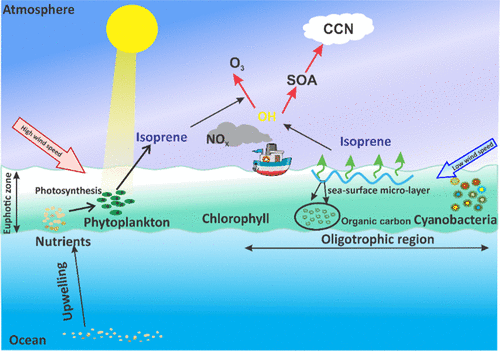当前位置:
X-MOL 学术
›
ACS Earth Space Chem.
›
论文详情
Our official English website, www.x-mol.net, welcomes your feedback! (Note: you will need to create a separate account there.)
High Levels of Isoprene in the Marine Boundary Layer of the Arabian Sea during Spring Inter-Monsoon: Role of Phytoplankton Blooms
ACS Earth and Space Chemistry ( IF 3.4 ) Pub Date : 2020-03-15 , DOI: 10.1021/acsearthspacechem.9b00325 Nidhi Tripathi 1, 2 , L. K. Sahu 1 , Arvind Singh 1 , Ravi Yadav 3 , Kusum Komal Karati 4
ACS Earth and Space Chemistry ( IF 3.4 ) Pub Date : 2020-03-15 , DOI: 10.1021/acsearthspacechem.9b00325 Nidhi Tripathi 1, 2 , L. K. Sahu 1 , Arvind Singh 1 , Ravi Yadav 3 , Kusum Komal Karati 4
Affiliation

|
The Arabian Sea possesses an intense oxygen minimum zone because of high primary productivity. These important biogeochemical aspects of the Arabian Sea have led us to investigate air–sea exchanges over the region. The measurements of the isoprene mixing ratio in marine air and biological parameters in seawater were conducted during the inter-monsoon period of April–May 2017. The year 2017 was the second warmest year since 1880 for the global ocean with positive sea surface temperature (SST) anomalies over the Arabian Sea during the campaign. The overall variation of isoprene follows the distribution of chlorophyll-a (Chl-a) with lower (0.38 ± 0.14 ppbv) and higher (0.75 ± 0.17 ppbv) values over central and northern regions, respectively. The diurnal pattern of isoprene covaries with solar flux, equivalent potential temperature, and wind speed as the daytime mixing ratio was ∼55% higher than its night-time value. Major enhancements (>0.6 ppbv) were associated with the blooms of Trichodesmium and Thalassiosira in oligotrophic conditions. High abundance of diatoms and cyanobacteria, intense solar flux, and high SST favored the production of isoprene from microbial sources. The estimated emission fluxes of isoprene were in the range of 1.5 × 107 to 1.2 × 108 molecules cm–2 s–1. Levels of isoprene in marine air and its emission fluxes were higher than the values reported for most of the other highly productive oceans. This study highlights implications of the “Arabian Sea Paradox” on regional atmospheric chemistry.
中文翻译:

春季季风之间阿拉伯海海洋边界层中的异戊二烯含量高:浮游植物绽放的作用
由于高初级生产力,阿拉伯海拥有一个极小的氧气最低带。阿拉伯海的这些重要生物地球化学方面已使我们研究了该地区的海-海交换。在2017年4月至5月的季风间隔期间对海洋空气中的异戊二烯混合比和海水中的生物参数进行了测量。2017年是自1880年以来全球海表温度为正温度(SST)的第二个最热年份。 )在竞选期间发生在阿拉伯海的异常情况。异戊二烯的整体变化遵循叶绿素a(Chl- a)在中部和北部地区分别具有较低的(0.38±0.14 ppbv)和较高的(0.75±0.17 ppbv)值。异戊二烯的日变化与日通量,太阳势通量,当量势温度和风速有关,比其夜间值高约55%。主要的增强作用(> 0.6 ppbv)与贫营养条件下的Trichodesmium和Thalassiosira的开花有关。硅藻和蓝藻的含量很高,强烈的太阳通量和较高的SST有利于从微生物来源生产异戊二烯。异戊二烯的估计排放通量在1.5×10 7至1.2×10 8分子cm –2 s –1的范围内。海洋空气中的异戊二烯水平及其排放通量高于其他大多数高产海洋的报告值。这项研究强调了“阿拉伯海悖论”对区域大气化学的影响。
更新日期:2020-04-23
中文翻译:

春季季风之间阿拉伯海海洋边界层中的异戊二烯含量高:浮游植物绽放的作用
由于高初级生产力,阿拉伯海拥有一个极小的氧气最低带。阿拉伯海的这些重要生物地球化学方面已使我们研究了该地区的海-海交换。在2017年4月至5月的季风间隔期间对海洋空气中的异戊二烯混合比和海水中的生物参数进行了测量。2017年是自1880年以来全球海表温度为正温度(SST)的第二个最热年份。 )在竞选期间发生在阿拉伯海的异常情况。异戊二烯的整体变化遵循叶绿素a(Chl- a)在中部和北部地区分别具有较低的(0.38±0.14 ppbv)和较高的(0.75±0.17 ppbv)值。异戊二烯的日变化与日通量,太阳势通量,当量势温度和风速有关,比其夜间值高约55%。主要的增强作用(> 0.6 ppbv)与贫营养条件下的Trichodesmium和Thalassiosira的开花有关。硅藻和蓝藻的含量很高,强烈的太阳通量和较高的SST有利于从微生物来源生产异戊二烯。异戊二烯的估计排放通量在1.5×10 7至1.2×10 8分子cm –2 s –1的范围内。海洋空气中的异戊二烯水平及其排放通量高于其他大多数高产海洋的报告值。这项研究强调了“阿拉伯海悖论”对区域大气化学的影响。


























 京公网安备 11010802027423号
京公网安备 11010802027423号